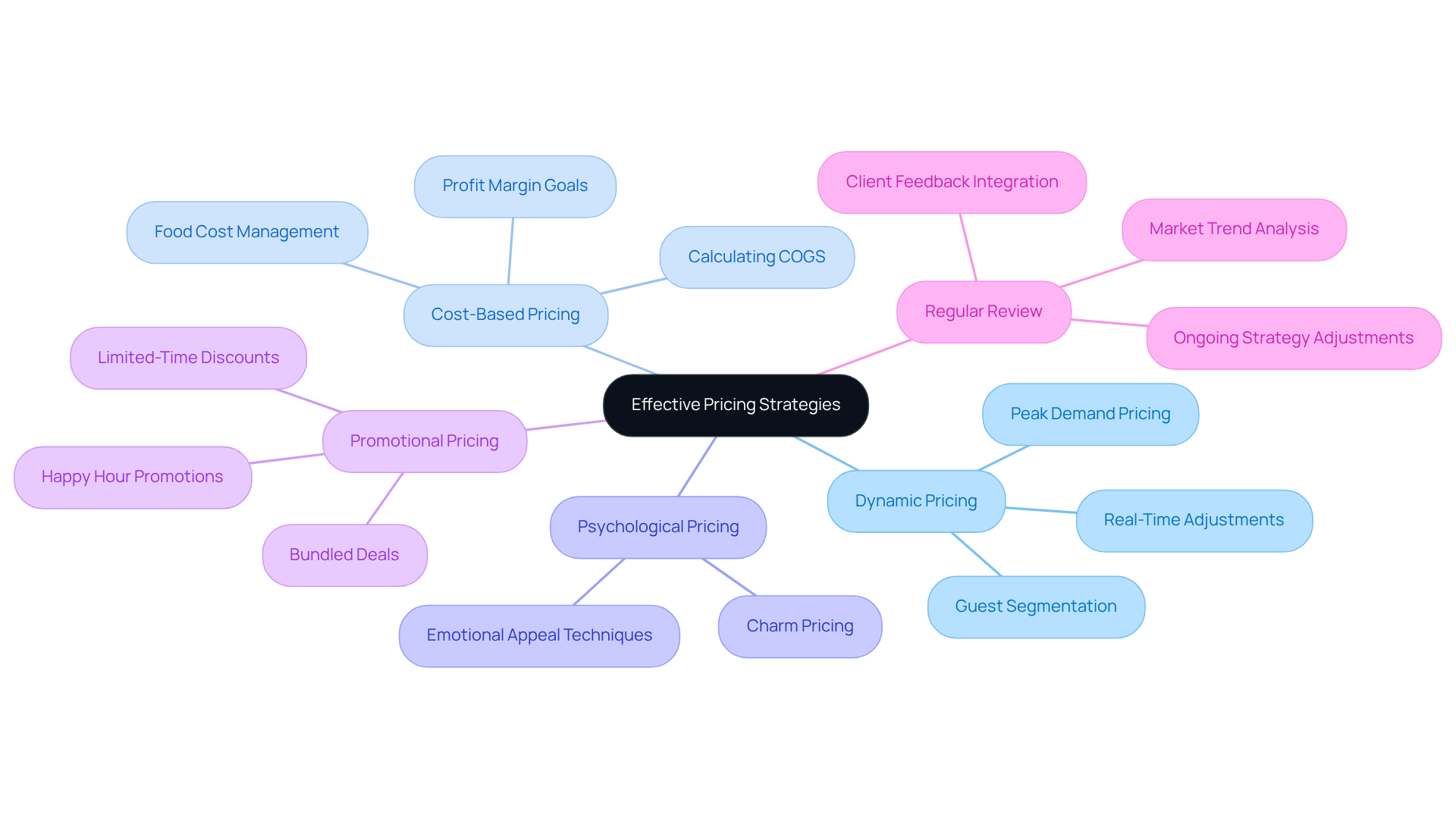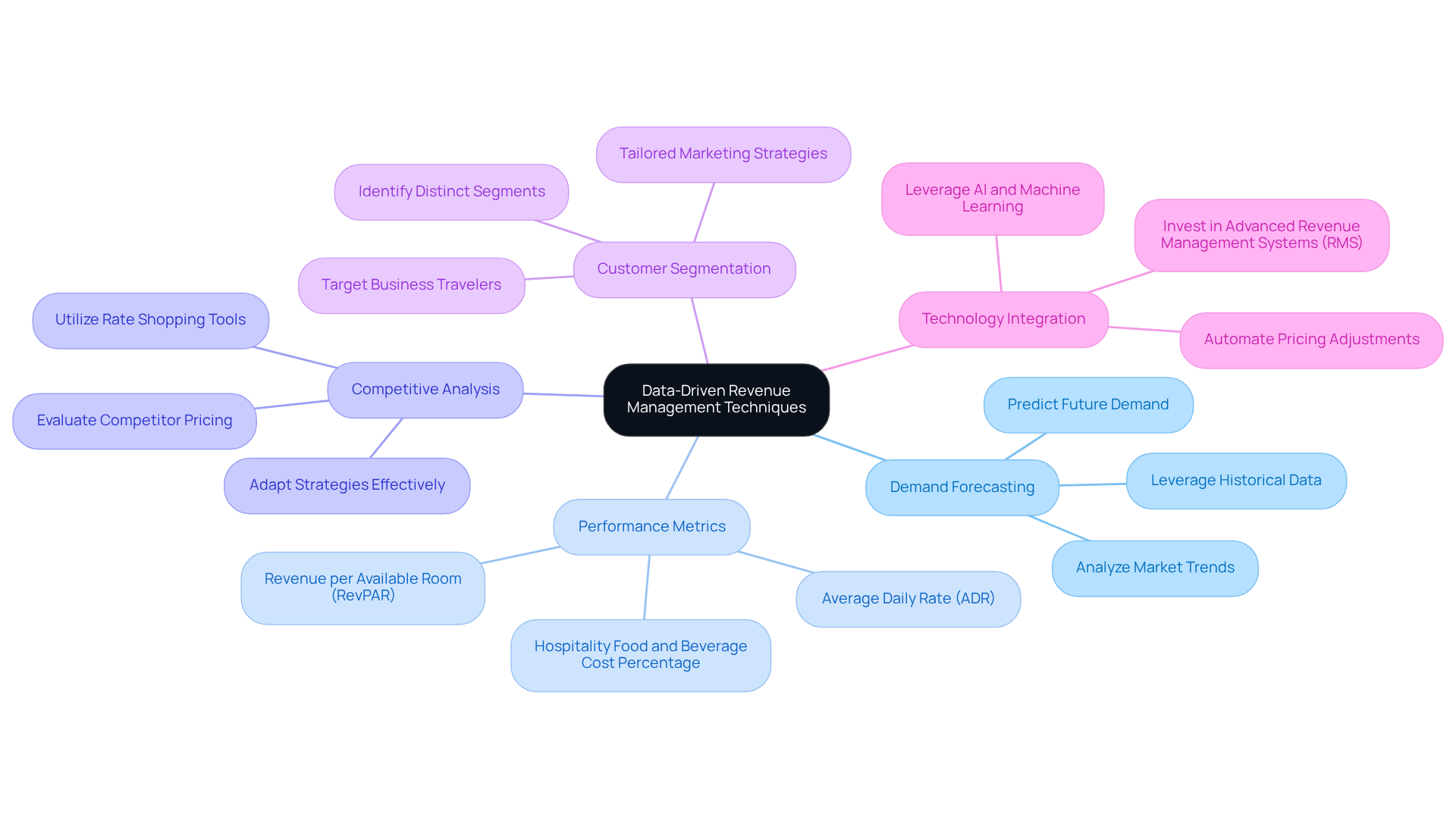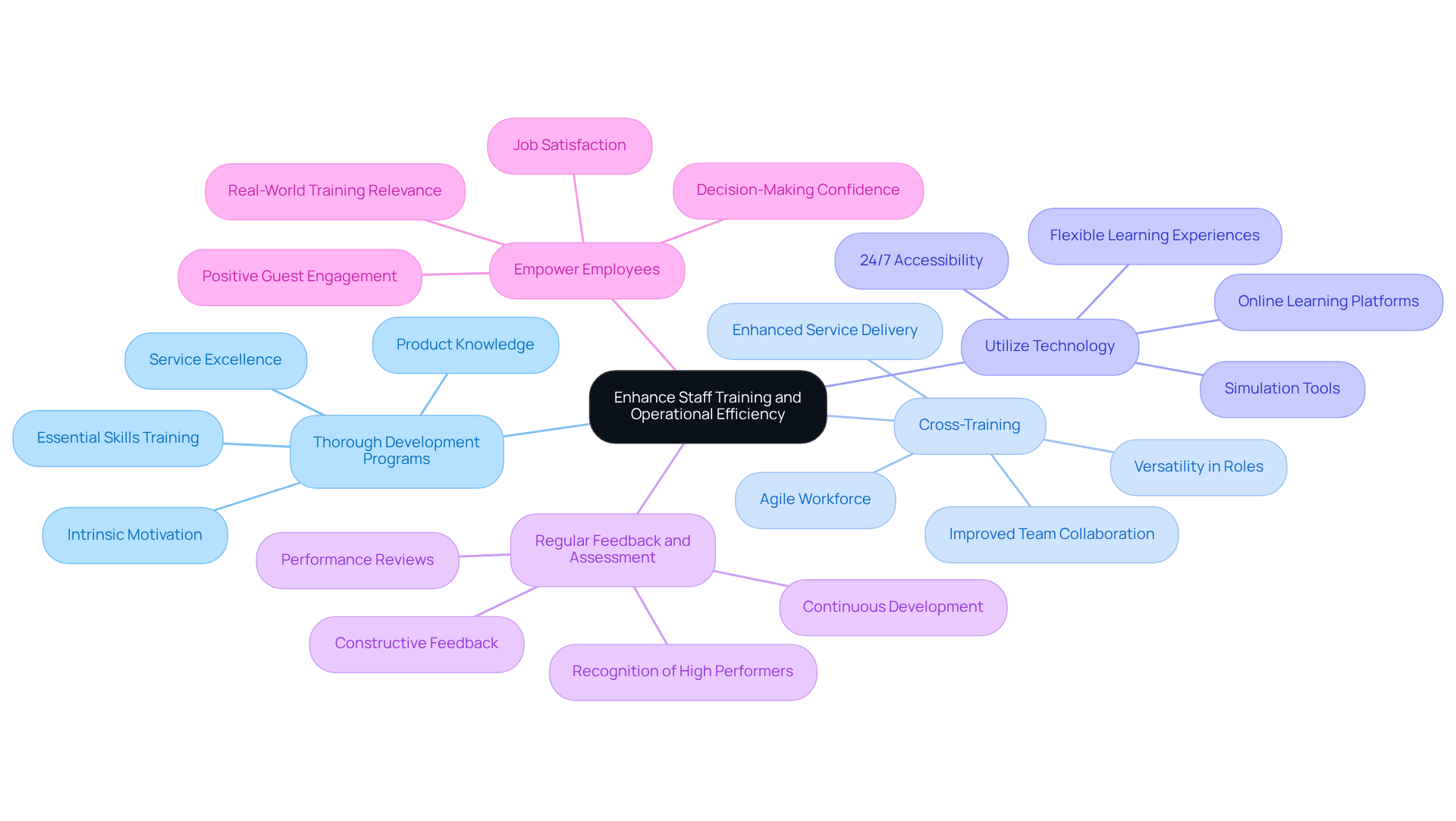Overview
This article outlines four key strategies for boosting profitability in the hospitality food and beverage sector:
- Effective pricing strategies
- Optimized menu design
- Data-driven revenue management
- Enhanced staff training
By implementing these strategies, hospitality businesses can significantly improve their financial performance. Each strategy is supported by specific practices and insights. For instance, utilizing dynamic pricing and psychological pricing can effectively increase revenue. Additionally, employing menu engineering allows businesses to highlight high-margin items, thereby optimizing sales. Furthermore, leveraging data for demand forecasting ensures that inventory and staffing align with customer needs. Finally, investing in staff training is crucial for improving service quality, which directly influences customer satisfaction and repeat business. By adopting these approaches, hospitality operators can position themselves for sustained profitability.
Introduction
In an industry where margins can be razor-thin, hospitality businesses are perpetually on the lookout for innovative strategies to enhance their food and beverage profitability. By implementing effective pricing strategies, optimizing menu offerings, leveraging data-driven revenue management, and enhancing staff training, establishments can unlock new avenues for financial success. However, the challenge lies in navigating these multifaceted strategies to ensure they align with evolving consumer preferences and market dynamics.
What are the most effective techniques that can be employed to not only survive but thrive in this competitive landscape?
Implement Effective Pricing Strategies
To implement effective pricing strategies, it is essential to consider several key steps.
- Dynamic Pricing: Adjusting prices based on real-time demand, competitor pricing, and local events can significantly enhance revenue. For instance, during peak tourist seasons, a slight increase in prices can maximize revenue without deterring clients.
- Cost-Based Pricing: Calculating the cost of goods sold (COGS) is crucial. Setting prices to ensure a healthy is vital, with food costs ideally remaining between 28% and 35% of menu prices to sustain profitability.
- Psychological Pricing: Techniques that appeal to consumers' emotions can be powerful. For example, pricing items at $9.99 instead of $10 can subtly influence purchasing decisions, leading to increased sales.
- Promotional Pricing: Offering limited-time discounts or bundled deals can effectively drive sales volumes. A 'happy hour' promotion, for instance, can attract more patrons during slower periods.
- Regular Review: Continuously analyzing pricing strategies is essential. Adjusting based on market trends and client feedback ensures ongoing profitability and relevance in a competitive landscape.

Optimize Menu Design and Offerings
To optimize menu design and offerings, it is crucial to follow these best practices:
- Menu Engineering: Conduct a thorough analysis of sales data to pinpoint high-margin and best-selling items. Research indicates that implementing price management can increase margins by 2 to 7% within a year. By placing these items prominently on the list, you can encourage purchases, as strategic positioning significantly affects buyer choices and enhances profitability.
- Visual Appeal: Utilize high-quality images and engaging descriptions to attract clients. Highlight signature dishes or chef specials to draw attention, as research shows that items with photos can experience sales that triple compared to those lacking images.
- Simplify Choices: Reduce the number of options available to ease decision fatigue for patrons. A brief selection results in faster service and boosts turnover; eateries with limited options often attain , suggesting enhanced patron satisfaction.
- Seasonal Offerings: Incorporate seasonal ingredients into the selections to keep offerings fresh and exciting. This method not only draws back previous patrons but also assists in managing food expenses efficiently. Adjusting offerings to ingredient availability can improve operational effectiveness.
- Feedback Loop: Regularly seek customer opinions on food items and make adjustments based on preferences and trends. Negative feedback should be viewed as a roadmap for improvement, ensuring the menu remains relevant and appealing. This proactive response to changing consumer demands enhances .
Utilize Data-Driven Revenue Management Techniques
To effectively harness data-driven revenue management techniques, it is crucial to consider the following strategies:
- Demand Forecasting: By leveraging historical data and analyzing market trends, you can accurately predict future demand. This insight allows for strategic adjustments to costs and inventory levels, ensuring optimal resource allocation.
- Performance Metrics: Monitoring key performance indicators (KPIs) such as average daily rate (ADR), revenue per available room (RevPAR), and hospitality food and beverage cost percentage is essential for assessing financial health. These metrics empower you to make informed, data-driven decisions that enhance profitability.
- Competitive Analysis: Regular evaluation of competitor pricing and offerings is vital to maintaining a competitive edge. Utilizing tools like rate shopping provides valuable insights into your , enabling you to adapt strategies effectively.
- Customer Segmentation: Analyzing customer data to identify distinct segments allows for tailored marketing strategies. For instance, targeting business travelers with specialized packages can significantly boost occupancy rates during weekdays.
- Technology Integration: Investing in advanced revenue management systems (RMS) that leverage AI and machine learning is imperative. These technologies automate pricing adjustments and optimize revenue strategies in real-time, ensuring your business stays ahead in a dynamic market.

Enhance Staff Training and Operational Efficiency
To enhance staff training and operational efficiency in the hospitality food and beverage sector, consider implementing the following strategies:
- Thorough Development Programs: Establish organized development initiatives that cover essential skills, service excellence, and detailed product knowledge. This approach ensures that staff are well-prepared to meet diverse customer needs, ultimately enhancing guest satisfaction. As noted by industry experts, effective development taps into intrinsic motivation, which is crucial for employee engagement.
- Cross-Training: Promote cross-training among staff to foster versatility and improve team collaboration. This strategy not only equips employees to handle multiple roles but also enhances service delivery during peak times, leading to a more agile workforce capable of adapting to fluctuating demands. A case study on the incorporation of Learning Management Systems (LMS) in hospitality education shows that cross-training can significantly enhance service consistency and employee morale.
- Utilize Technology: Leverage technology for educational purposes by incorporating and simulation tools. These resources offer staff flexible and engaging learning experiences, enabling them to study at their own pace and on their own schedules, which is essential in the 24/7 hospitality environment. The hospitality food and beverage sector has made significant strides in adopting technology to enhance the relevance and effectiveness of education.
- Regular Feedback and Assessment: Implement a systematic approach for regular performance reviews and constructive feedback. This practice helps identify areas for improvement while recognizing high performers, fostering a culture of continuous development and accountability. Statistics suggest that well-structured hospitality education initiatives can result in a 25% rise in guest satisfaction, highlighting the significance of continuous evaluation.
- Empower Employees: Cultivate a culture of empowerment where staff feel confident in making decisions that enhance customer experiences. This not only boosts job satisfaction but also leads to improved service delivery, as empowered employees are more likely to engage positively with guests. As highlighted in industry discussions, the biggest challenge for hospitality training programs is often relevance; thus, ensuring that training is applicable to real-world scenarios is essential for success.
By implementing these strategies, hospitality businesses can expect improved employee retention, enhanced guest experiences, and a more efficient operational framework.

Conclusion
Implementing effective strategies to boost profitability in the hospitality food and beverage sector is not just beneficial; it is essential for success in a competitive market. By focusing on:
- Pricing strategies
- Menu optimization
- Data-driven revenue management
- Enhanced staff training
businesses can significantly elevate their financial performance and customer satisfaction.
Key insights highlight the importance of:
- Dynamic and psychological pricing to maximize revenue
- The value of menu engineering to showcase high-margin items
- The necessity of leveraging data analytics for informed decision-making
Furthermore, fostering a culture of continuous improvement through staff training and operational efficiency can lead to superior service delivery and enhanced guest experiences.
In a rapidly evolving industry, embracing these strategies not only ensures a competitive edge but also cultivates a loyal customer base. By prioritizing profitability through thoughtful pricing, appealing menu designs, informed revenue management, and empowered staff, hospitality businesses can thrive and adapt to changing consumer demands. Taking decisive action on these best practices is crucial for achieving long-term success and sustainability in the hospitality food and beverage landscape.
Frequently Asked Questions
What are the key steps to implement effective pricing strategies?
The key steps include dynamic pricing, cost-based pricing, psychological pricing, promotional pricing, and regular review of pricing strategies.
What is dynamic pricing?
Dynamic pricing involves adjusting prices based on real-time demand, competitor pricing, and local events to enhance revenue, such as increasing prices during peak tourist seasons.
How is cost-based pricing determined?
Cost-based pricing is determined by calculating the cost of goods sold (COGS) and setting prices to ensure a healthy profit margin, with food costs ideally between 28% and 35% of menu prices.
What is psychological pricing and how does it work?
Psychological pricing uses techniques that appeal to consumers' emotions, such as pricing items at $9.99 instead of $10, which can influence purchasing decisions and increase sales.
What is promotional pricing and how can it be effective?
Promotional pricing involves offering limited-time discounts or bundled deals to drive sales volumes, such as a 'happy hour' promotion that attracts more patrons during slower periods.
Why is it important to regularly review pricing strategies?
Regularly reviewing pricing strategies is essential to analyze market trends and client feedback, ensuring ongoing profitability and relevance in a competitive landscape.


